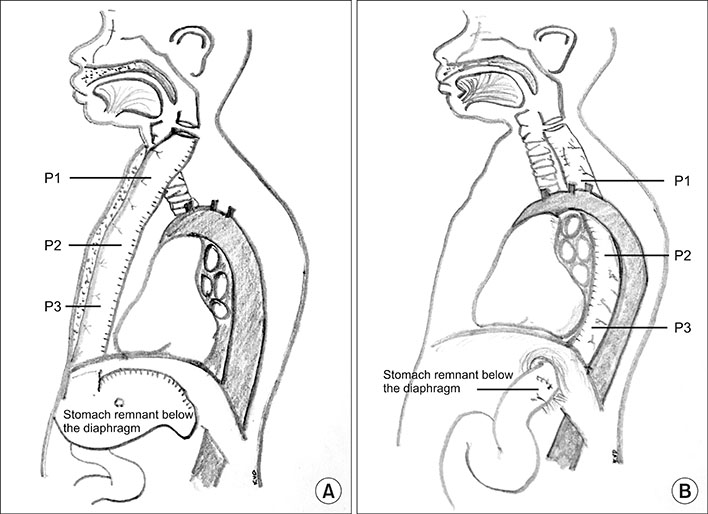Pediatr Gastroenterol Hepatol Nutr.
2018 Oct;21(4):257-263. 10.5223/pghn.2018.21.4.257.
Twenty-Four Hour pH Study and Manometry in Gastric Esophageal Substitutes in Children
- Affiliations
-
- 1Department of Paediatric Surgery, Lokmanya Tilak Municipal Medical College, Mumbai, India. kvisheshd@gmail.com
- 2Department of Paediatric Surgery, Mahatma Gandhi Memorial Medical College and Maharaja Yashwantrao Hospital, Indore, India.
- KMID: 2421987
- DOI: http://doi.org/10.5223/pghn.2018.21.4.257
Abstract
- PURPOSE
Studies on the physiology of the transposed stomach as an esophageal substitute in the form of a gastric pull-up or a gastric tube in children are limited. We conducted a study of motility and the pH of gastric esophageal substitutes using manometry and 24-hour pH measurements in 10 such patients.
METHODS
Manometry and 24 hour pH studies were performed on 10 children aged 24 to 55 months who had undergone gastric esophageal replacement.
RESULTS
Six gastric tubes (4, isoperistaltic; 2, reverse gastric tubes) and 4 gastric pull-ups were studied. Two gastric tubes and 4 gastric pull-ups were transhiatal. Four gastric tubes were retrosternal. The mean of the lowest pH at the midpoint of the substitute was 4.0 (range, 2.8-5.0) and in the stomach remaining below the diaphragm was 3.3 (range, 1.9-4.2). In both types of substitute, the difference between the peak and the nadir pH recorded in the intra-thoracic and the sub-diaphragmatic portion of the stomach was statistically significant (p < 0.05), with the pH in the portion below the diaphragm being lower. The lowest pH values in the substitute and in the remnant stomach were noted mainly in the evening hours whereas the highest pH was noted mainly in the morning hours. All the cases showed a simultaneous rise in the intra-cavitatory pressure along the substitute while swallowing.
CONCLUSION
The study suggested a normal gastric circadian rhythm in the gastric esophageal substitute. Mass contractions occurred in response to swallowing. The substitute may be able to effectively clear contents.
MeSH Terms
Figure
Reference
-
1. Hölscher AH, Voit H, Buttermann G, Siewert JR. Function of intrathoracic stomach as esophageal replacement. World J Surg. 1988; 12:835–844.2. Gupta DK, Charles AR, Srinivas M. Manometric evaluation of the intrathoracic stomach after gastric transposition in children. Pediatr Surg Int. 2004; 415–418.
Article3. Fung KP, Math MV, Ho CO, Yap KM. Midazolam as a sedative in esophageal manometry: a study of the effect on esophageal motility. J Pediatr Gastroenterol Nutr. 1992; 15:85–88.4. Davenport M, Hosie GP, Tasker RC, Gordon I, Kiely EM, Spitz L. Long term effects of gastric transposition in children: a physiological study. J Pediatr Surg. 1996; 31:588–593.
Article5. Hirschl RB, Yardeni D, Oldham K, Sherman N, Siplovich L, Gross E, et al. Gastric transposition for esophageal replacement in children: experience with 41 consecutive cases with special emphasis on esophageal atresia. Ann Surg. 2002; 236:531–539. discussion 539-41.6. Collard JM, Romagnoli R, Otte JB, Kestens PJ. The denervated stomach as an esophageal substitute is a contractile organ. Ann Surg. 1998; 227:33–39.
Article7. Powe JE, Casson AG, Inculet RI, Laurin N, Finley RJ. Functional evaluation of gastric interposition following total esophagectomy. In : Proceeding of the 37th Anuual Meeting of Nuclear Medicine; 1990. 31:p. 775. (abstract).8. Ravelli AM, Spitz L, Milla PJ. Gastric emptying in children with gastric transposition. J Pediatr Gastroenterol Nutr. 1994; 19:403–409.
Article9. Romeo G, Giovinetto A, Sanfilippo G, Calì R, Catania G, Basile F. Follow-up study in 402 patients after parietal cell vagotomy for duodenal ulcer. Int Surg. 1981; 66:303–306.10. Nagita A, Amemoto K, Yoden A, Aoki S, Sakaguchi M, Ahida K, et al. Diurnal variation in intragastric pH in children with and without peptic ulcers. Pediatr Res. 1996; 40:528–532.
Article11. Gutschow C, Collard JM, Romagnoli R, Salizzoni M, Hölscher A. Denervated stomach as an esophageal substitute recovers intraluminal acidity with time. Ann Surg. 2001; 233:509–514.
Article12. Patterson M, Rintala R, Lloyd DA. A longitudinal study of electrogastrography in normal neonates. J Pediatr Surg. 2000; 35:59–61.
Article
- Full Text Links
- Actions
-
Cited
- CITED
-
- Close
- Share
- Similar articles
-
- High-resolution esophageal manometry in children
- Achalasia Previously Diagnosed as Gastroesophageal Reflux Disease by Relying on Esophageal Impedance-pH Monitoring: Use of High-Resolution Esophageal Manometry in Children
- 24-hour Ambulatory Esophageal Manometric Finding in Nutcracker Esophagus
- A Study of Esophageal Acidity and Motility Change after a Gastrectomy for Stomach Cancer
- Laparoscopic Partial Fundoplication in Case of Gastroesophageal Reflux Disease Patient with Absent Esophageal Motility


